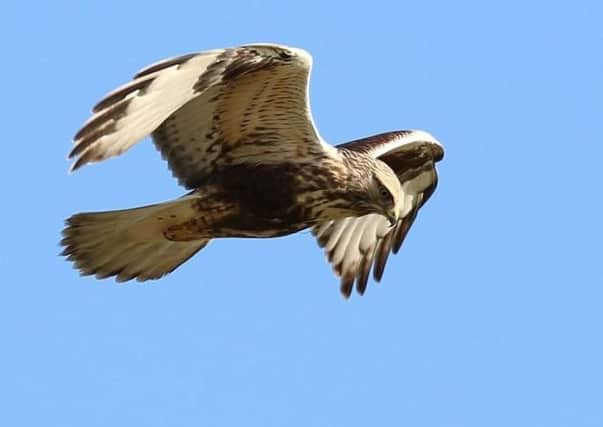An uncommon visitor from the tundra


A juvenile rough-legged buzzard was hunting over fields at Buckton just to the north of the Bempton Cliffs RSPB reserve and was seen to go into roost on the cliffs while there have been other sightings further north at Speeton and Filey.
Rough-legged, pictured, are the most northerly occurring of the buzzards and so named because, to cope with the extreme cold of their breeding range in northern Scandinavia and Siberia the feathering on their legs extends to the talons.
Advertisement
Hide AdAdvertisement
Hide AdNumbers seen here each winter are very much determined by the abundance or otherwise of prey on their breeding grounds.
Rough-legged buzzards feed mainly on voles and lemmings and both these have cycles of abundance with a peak every three or four years followed by a slump.
In peak years, the buzzards can lay five to six eggs as opposed to the usual two or three and, with plenty of food available, the young survive and prosper and, as winter approaches, some move south to more temperate climates in this country and Europe.
Once here some of them will set up a winter territory sometimes alongside resident common buzzards although any stretch of open country with a plentiful supply of rabbits to hunt can be chosen.
Advertisement
Hide AdAdvertisement
Hide AdThe Bempton bird may follow the example of another juvenile which arrived at Grindale, only two or three miles away in the autumn of 2014, and stayed until February the following year, showing little fear of humans.
One or two rough-legged buzzards can winter around Sleddale and Bransdale on the North York Moors while in some years others might be seen almost anywhere.
Caution is needed in identifying rough-legged from common buzzard. Rough-legged are slightly larger and generally paler but some common buzzards can also be pale. The rough-legged tends to hover more while hunting prey but some common buzzards can also hover frequently.
The best ID feature to look for is the rough-legged’s white tail with dark bands running along the edge – a juvenile has a single band, a female two or three and an adult male three or four.
Advertisement
Hide AdAdvertisement
Hide AdThe cold winds also brought more ducks from the north with scaup at a number of sites including three at Hellifield Flash, North Yorkshire, two at the North Cave wetland and Kilnsea and others at Hornsea Mere and Fairburn Ings. Hawfinches have continued to be seen including in some gardens while at least 25 were still at the Yorkshire Arboretum at Castle Howard. The arboretum closed this week and will not reopen until February when hopefully the hawfinches will still be there.
There were still some reminders of summer with a house martin seen over Scarborough’s old town and a swallow over Wrench Green, East Ayton.